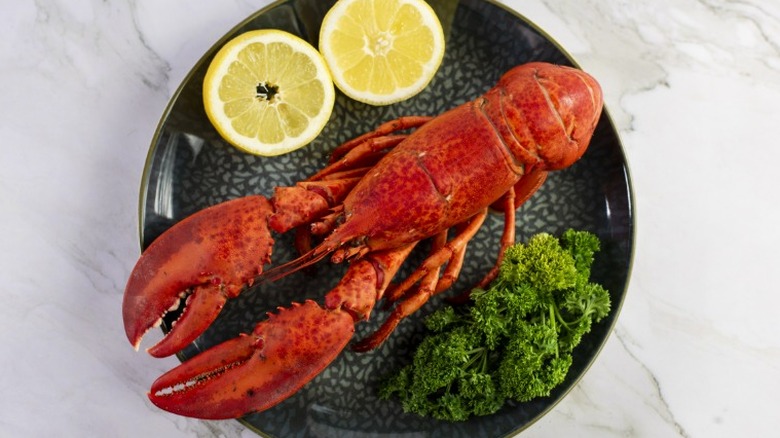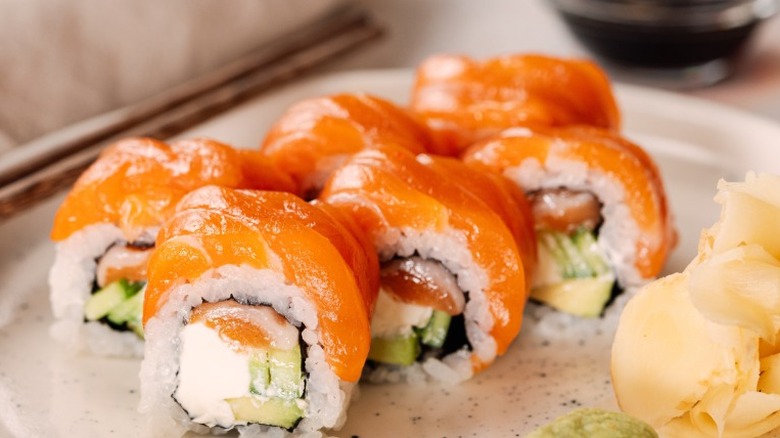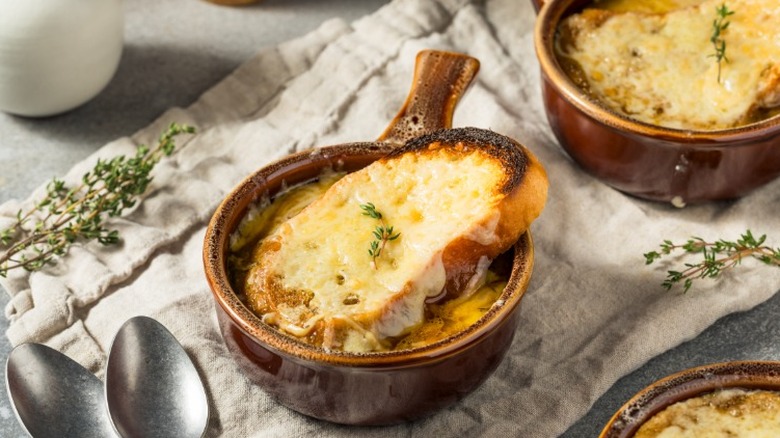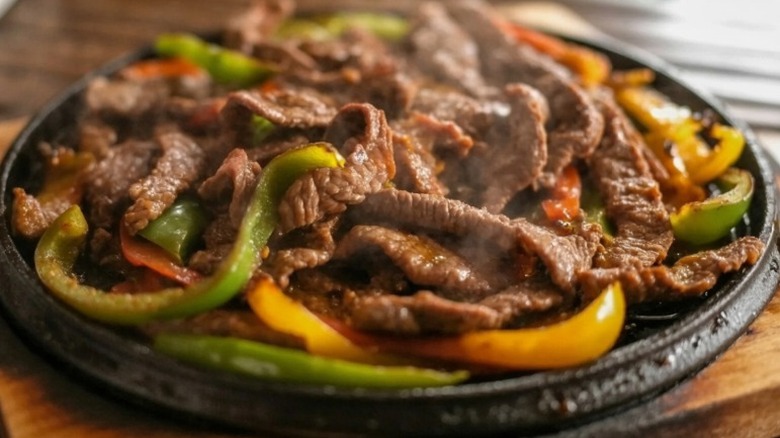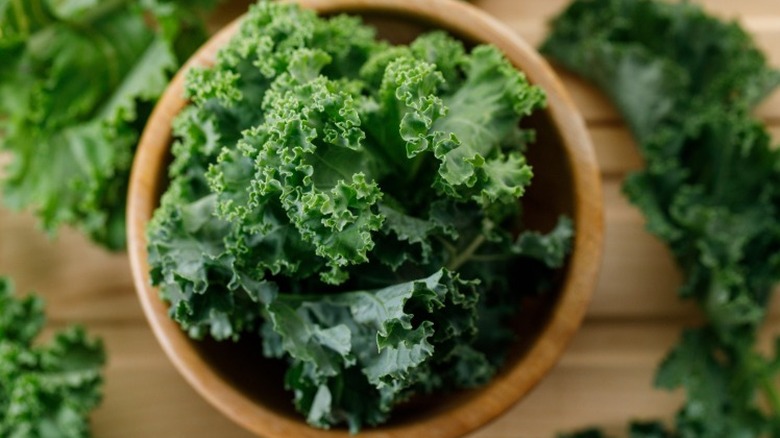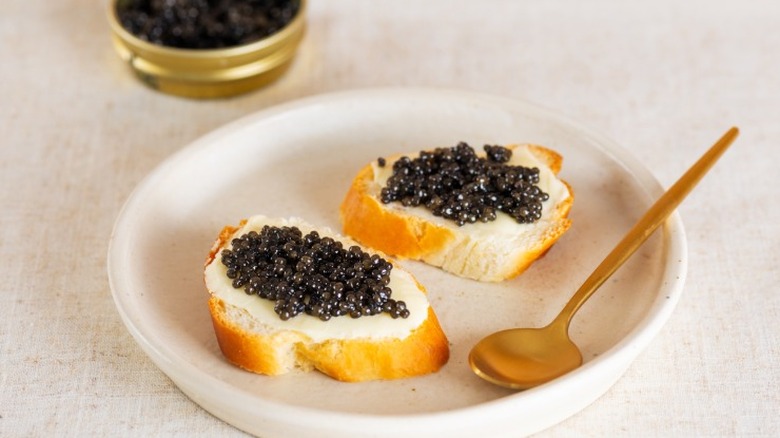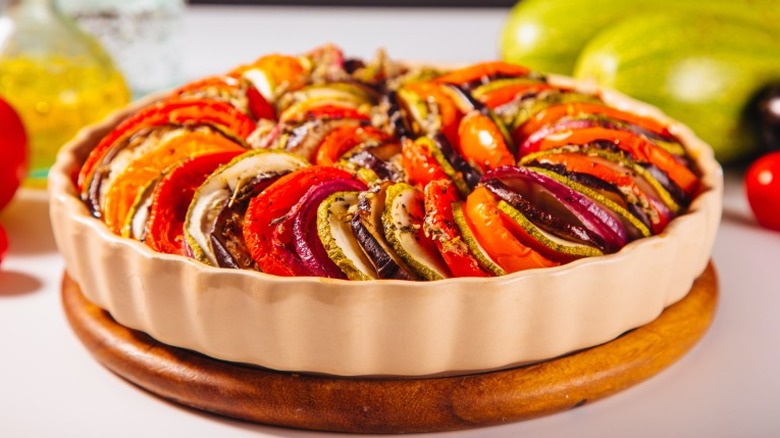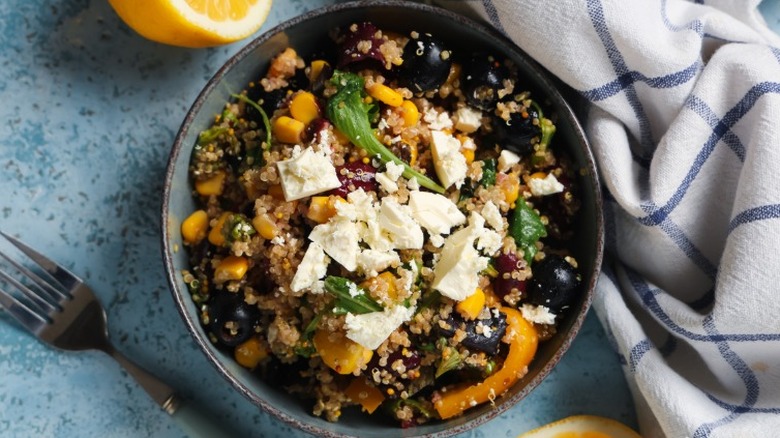12 Items That Used To Be Considered 'Poor Man's Food'
Sometimes the best dishes are those that don't require hours of prep work and expensive ingredients. While the label "poor man's food" can carry a negative connotation, this term simply refers to foods that are cost-effective. Around the world, these foods, while born out of necessity, are often deeply ingrained in the history and traditions of those who eat them. And just because the ingredients are easily accessible, doesn't mean flavor has to be sacrificed. Many of these dishes easily rival their more luxurious counterparts. So much so that years later, foods that the rich would have once looked at with scorn become the newest trend. You may be surprised to find that some of your own favorite foods weren't always held in such high regard.
As economic and environmental factors shift over time, what's most accessible inevitably changes. You might remember a time when you could purchase a dozen eggs for about two dollars. Over the past few years, with stores limiting how many eggs customers can buy, that became unthinkable. The items on this list experienced similar changes. While once mundane, they are now considered staples and even luxury dishes.
Lobster
Have you ever found yourself in a restaurant asking, "Why does lobster cost so much?" You should know it used to be quite the opposite. Nowadays, lobster is in high demand yet difficult to farm, both factors that contribute to its steep price tag. In the past, however, lobster was so abundant that you could find piles of the crustaceans washed up along New England shores. Because of this surplus, it's said that lobster was fed to prisoners and indentured servants throughout the 1700s. That tender meat you savor now was even used as fertilizer once.
It wasn't until the 1800s that lobster began to make the shift from "poor man's food" to commonplace and, later, to luxury. The biggest catalyst was the rise of train transportation. Lobster became a common meal served to train passengers, many of whom did not live near coastal areas where the crustacean was plentiful. To them, it was an intriguing new dish. Eventually, word spread, and by the time World War II rolled around, it had become synonymous with fine dining. From fertilizer to five-star Michelin, lobster certainly got the revamp of the century.
Fondue
What more versatile dish is there than fondue? When the cold starts to creep in, a group can huddle around a big pot of gooey cheese and turn any number of foods into acceptable vessels. Fondue can be hearty when paired with meats or sweet and savory if fruit is dipped in. There are even restaurants wholly dedicated to the art of melted cheese. But at its core the dish's simplicity speaks to its humble origins.
Much like today, as people seek out warm fondue on a chilly day, families in 18th-century Switzerland ate the dish to make the most out of the winter months when food was scarce. By combining leftover cheese with wine and flour, you had an easy, filling meal that could serve many. They could also use up any bread, even if it had gone stale, as the melted cheese would help soften it. It rose to popularity in the 1930s, when the Swiss Cheese Union deemed it the national dish of Switzerland. Now, fondue has found love beyond the Alps and is a delicious meal, more than just a means to get by.
Sushi
Sushi has become ubiquitous in Japan despite not actually originating in the country. The earliest version of sushi actually got its start in Southeast Asia, where fish was fermented in rice to keep it fresh for a year or more. The rice itself was thrown out in favor of savoring the fish alone, so it wasn't quite like today's sushi, but it was a good way for the farmers to stretch their food. This preservation method spread into parts of China and, at last, made its way to Japan.
The people there began reducing the fermentation time and eating the rice and fish as a pair rather than tossing the rice. Later, the addition of vinegar to rice helped mimic the flavors of fermentation while being less time-consuming. Sushi was quickly becoming a staple for everyone, not just the poor. When the bite-sized nigiri we know and love today came about, workers could have it as a quick and affordable snack or meal. Sushi is now found all over the world and can be found for cheap at grocery stores or at a steeper price in high-end restaurants. However it's enjoyed, it's certainly no longer as limited as it once was.
French onion soup
Soup is a classic comfort food with too many variations to count. Some are simple, while others require a little more love to achieve a perfect bowl. One such soup is French onion soup, the classic French dish that gets its deep flavor from a mixture of caramelized onions, wine, and rich broth. It requires patience to achieve just the right level of caramelization on the onions, and a bowl topped with gratinéed cheese and crusty bread is a welcome sight at any table.
Trace the dish back in time and you'll find that very early versions of onion soups were consumed often by the ancient Romans. Then, onions were an easy crop to cultivate and were found in abundance, so onion soup was a fitting meal for the poor populations. A more familiar iteration of French onion soup found its origin in 18th-century Paris, France, where the classic broth and caramelized onion combination began.
At these Parisian markets, the soup was a common dish served, as its components were still readily available. Thus, it became the warming staple of French culture it is now and also spread outside of the country. Even famous American chef Julia Child chose to have a bowl of French onion soup as her final homecooked meal, a testament to the dish's popularity.
Bread pudding
Bread pudding is one of the less surprising items on this list. Even today, bread pudding is a great way to turn food that would otherwise go to waste into a tasty dessert or even a savory dish. Of course, the modern take on bread pudding isn't quite as simple as it once was. The original bread pudding dates back to around the 11th or 12th century in England, where it was called "poor man's pudding." Old stale bread could be repurposed into perfectly good food on a budget.
While today, bread pudding is made with a creamy custard blend of eggs, milk, and spices, cooks in the past didn't have the same access to ingredients. Instead, they soaked the stale bread in hot water and dried it before mixing in spices. Around the 13th century, people introduced the eggs and milk to the recipe. Since then, all kinds of different mix-ins and flavors have been added. Many different countries have their own versions of bread pudding. While bread pudding is much more widespread now, it is still at its core a simple and effective dish. It can always be elevated with high-quality ingredients. But even leftover hot dog buns can be turned into a deliciously sweet bread pudding.
Fajitas
Nothing says Tex-Mex quite like a piping hot plate of fajitas. But the dish can get pretty pricey depending on the restaurants you frequent. Though fajitas made with skirt steak, one of the more popular options, actually originated as one of the cheaper cuts of meat people could eat. "Fajitas" literally translates to "small strip" and referred to the less favored pieces of meat ranchers and vaqueros would eat in the 1930s. The tougher pieces of skirt steak were often included as their pay and cooked over coals to make a hearty meal with tortillas.
Fajitas soon became popular in southern Texas and could be found served at outdoor festivals. Next, Mexican restaurants throughout Texas and later, the entire United States, began adding the dish to their menus, making it into a mainstay of Tex-Mex cuisine. However, while skirt steak used to be the affordable cut, modern prices certainly don't reflect its humble origins. Luckily, there are many more options for fajitas now, from chicken to vegetable fajitas.
Kale
It seems like every day there's a new trendy health food making the rounds on social media. One of the most popular "superfoods" to take the internet by storm in the past few years has been kale. This cruciferous vegetable has an earthy bitterness to it and is a good source of fiber and essential vitamins. Influencers have made about every variation of a kale salad you can imagine and even touted them as a potato chip replacement, which we have our doubts about. But how did such a simple vegetable gain such popularity? Turns out, it's been a staple long before any internet clout.
In fact, kale was actually so abundant that it was largely livestock that ate it. Humans would eat it only when they had to and referred to it as "peasant cabbage." Its resistance to cold temperatures made kale a staple in harsh winters throughout England and in the United States when it was introduced in the 17th century. It was even grown in Britain as part of a World War II campaign due to its penchant for survival. The general aversion to kale unless absolutely necessary is a far cry from the demand it's associated with today.
Caviar
Most people who see a plate of caviar arrive at their table will hold on a little tighter to their wallets. Though unassuming enough in appearance, caviar can range from $60 to upwards of $7,000. This is one of those foods that immediately screams luxury and is considered a delicacy around the world. But why is caviar so expensive? Well, despite such high demand, the painstakingly slow process of harvesting fish eggs means supply isn't as abundant as you might expect.
However, while today just a small amount of caviar is enough to break the bank, it actually used to be quite affordable. The sturgeon, the fish that caviar comes from, was once an abundant food source in places like Persia and Russia. Sturgeon lived in large populations in the Caspian Sea, and those that lived in the area would use the entire fish, eggs included. Since it was so plentiful, it was a staple for many families. When caviar eventually reached the United States in the 1800s, it was still not seen as a delicacy.
Saloon patrons were sometimes offered a helping of caviar as an incentive to purchase more alcohol. Restaurants could sell caviar for a nickel. But unfortunately, as demand increased and overfishing became a prominent issue, the Caspian Sea, which once teemed with sturgeon, became depleted. That demand still hasn't dwindled, even as fish populations have, leaving us with a food not everyone can afford to enjoy.
Ratatouille
Regardless of your cooking experience, you probably recognize this next dish as the title of the film Anthony Bourdain named "the best food movie ever made." The 2007 Pixar film did give ratatouille a boost in popularity, but despite its coveted gourmet status in the movie, it's another dish born of necessity. This classic stewed vegetable dish came about in the Provence region of France.
In the 18th century, farmers in this southern countryside made the dish to use up leftover vegetables from the end-of-season harvest. They would stew the vegetables slowly over hours to make them into a dish that revived their flavor. Since meat wasn't accessible to many of these farmers, ratatouille has traditionally been made vegetarian. In the 20th century, it appeared for the first time on restaurant menus. While it originated in the southeast regions of France, it spread across the country, including to major hubs like Paris. Today, it's a staple dish that uses seasonal vegetables like eggplant, zucchini, and tomatoes and is cooked in different ways, all of which Remy himself would be satisfied with.
Quinoa
Like kale, quinoa has a reputation for being a superfood for all the antioxidants, fiber, and other nutrients it contains. And just like its leafy friend, it's become somewhat of a social media star in recent years with all kinds of recipes utilizing it to its fullest. But in countries where quinoa has been traditionally grown for centuries, it's not a trend but a staple. Quinoa originated in the Andes, where it has been grown for more than 5,000 years.
When Spanish colonizers arrived in the region, they looked down on the food, seeing it as only suitable for the poor populations to eat, and replaced it with foreign crops. However, in countries like Bolivia and Peru, quinoa was a common meal, especially among indigenous populations, and could be made into filling porridges, baked, or otherwise cooked. The great thing about quinoa is that it is a low-maintenance crop that doesn't require highly controlled growing conditions. This means it has been and continues to be used in times of food insecurity. So while Western consumers just recently tuned in to the benefits of quinoa, history shows it's always been a cornerstone of international cuisine.
Carrot cake
Carrot cake can be a polarizing dessert choice. Some scoff at the idea of a vegetable being anywhere near their dessert, let alone the main character. Even between carrot cake lovers, there's a divide. Do raisins belong in carrot cake? What about pineapple and coconut? However, for all the debate, carrot cake is a pretty classic cake throughout the U.S., even though its origins point elsewhere.
Turn the time machine back to the Middle Ages in Europe and you'll stumble across the earliest version of carrot cake, which was more of a carrot pudding than a cake. At this time, the typical sweeteners of honey and sugar were luxuries. Carrots, with their natural sweetness, were an innovative substitute and, when combined with dried fruits and spices, made for a coveted flavor profile. As ingredients like baking powder became more accessible, the steamed puddings began to take on a more cake-like texture. In the United States, carrot cake made its first appearance in a cookbook titled "The 20th Century Bride's Cookbook." The recipe continued to evolve until it reached the moist, cream-cheese-icing-topped cake known and loved today.
Oysters
Another food that has survived the test of time is oysters. As we know them now, oysters are a staple of seafood dishes and have been for over 2,000 years. These mollusks were being consumed as early as the Roman Empire, as well as in ancient China. Even in the 18th and 19th centuries, throughout both Europe and America, oysters were far from a delicacy. In fact, they were about as mundane as could be.
When they were at peak abundance, oysters were eaten by pretty much everyone. The wealthy enjoyed them in myriad ways, while the poor turned to them in lieu of meat. Throughout the Middle Ages, in places like France and the U.K., oysters were prominent along the coast, where people would flock to harvest them. But just as overfishing led to an imbalance in supply and demand for caviar, so too did oysters experience a depletion in numbers.
As their popularity grew, authorities in France tried to limit the fishing to no avail. By the 20th century, the oyster populations had largely diminished even as they had become a symbol of luxury, sought after by high-class restaurant-goers. Oyster farming has undergone various changes to be more sustainable, however, and oysters are again a popular food in restaurants around the world.

